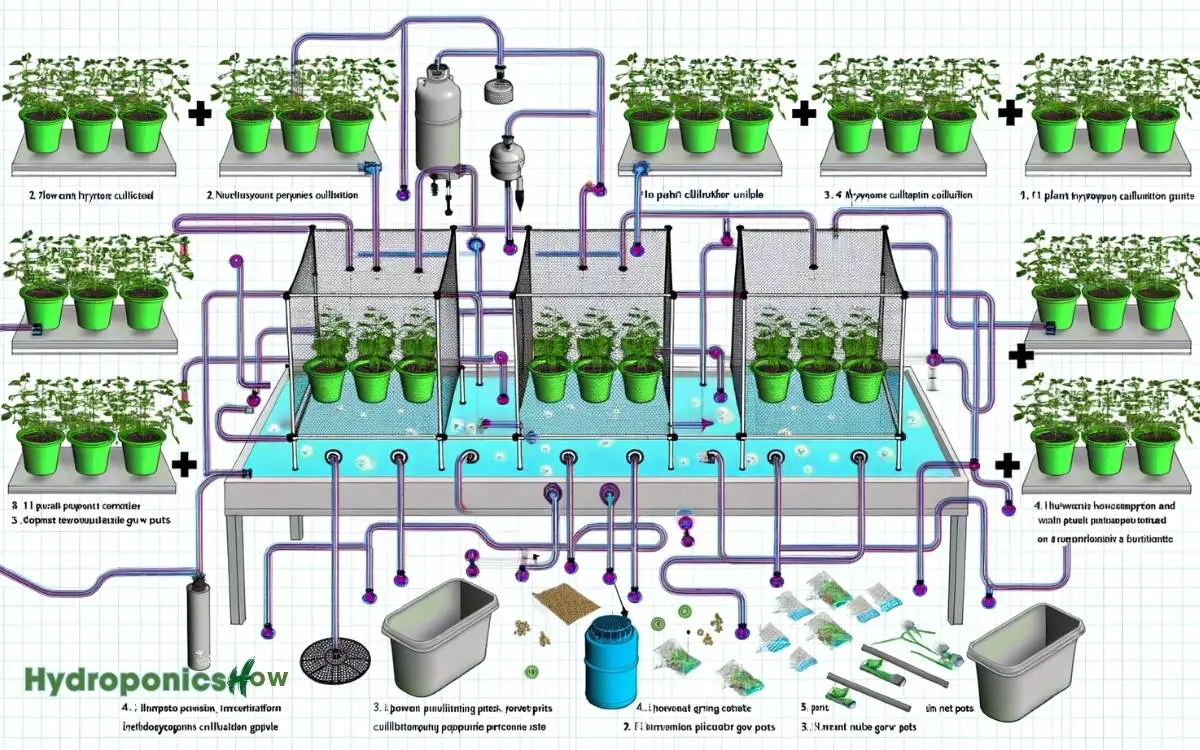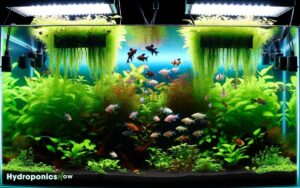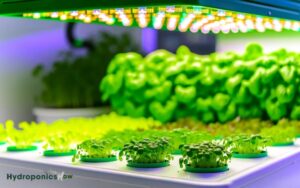Build Your Own DIY Hydroponic System for 4 Plants in 5 Simple Steps
Creating a DIY 4-plant hydroponic system is simple with the right materials and steps.
First, gather a container, net pots, growing medium, air pump, and nutrient solution. Drill holes in the container for the net pots, smoothing edges with sandpaper.
Stabilize the container using PVC pipes and cement. Position the reservoir beneath, drilling a hole for the pump’s cord. Connect the pump to tubing and add an air stone.
Fill the reservoir with water and nutrient solution. Monitor pH levels (5.5-6.5), replace nutrients bi-weekly, provide 14-16 hours of light, and maintain water temperature (65-75°F). Success awaits!

Key Takeaways
Gather Your Materials
To begin creating your 4-plant hydroponic system, you’ll need to gather specific materials including a container, net pots, growing medium, air pump, air stone, tubing, nutrient solution, and pH testing kit. Choose a container that’s opaque to prevent algae growth. Drill holes in the lid of the container to hold the net pots securely, ensuring proper support for your plants. Insert the air stone into the container and connect it to the air pump with tubing to provide oxygen to the roots. With these essential components in place, you’ll be ready to grow hydroponic plants at home efficiently and successfully.
Net pots will hold your plants, while the growing medium, such as clay pellets or rockwool, provides support. The air pump and air stone work together to oxygenate the nutrient solution, essential for root health. Connect these with flexible tubing.
The nutrient solution should be hydroponics-specific, providing all essential minerals. Finally, a pH testing kit helps maintain the solution within the ideal range for most plants, typically between 5.5 and 6.5. Ensuring you have these items will set a solid foundation.
Construct the Frame
Begin constructing the frame by drilling evenly spaced holes into the lid of your chosen container, making sure they match the diameter of your net pots for a secure fit. Measure and mark the positions accurately to maintain uniform spacing.
Use a power drill with a hole saw attachment to create clean, precise openings. After drilling, smooth any rough edges with sandpaper to guarantee no damage to the net pots.
Next, stabilize the frame by attaching PVC pipes to form a supportive structure. Cut the PVC pipes to the required lengths and connect them using T-joints and elbow joints.
Secure the joints with PVC cement for durability. Confirm the frame is level and sturdy to support the net pots and nutrient solution effectively.
Set Up the Reservoir
Once the frame is constructed, position your reservoir container directly beneath it to hold the nutrient solution efficiently. Make sure the container is opaque to prevent algae growth.
Drill a hole near the top for the submersible pump‘s power cord. Attach the pump, making certain it’s secured at the bottom.
Connect the pump’s outlet to the tubing, leading it to your plant sites. Insert an air stone connected to an air pump to oxygenate the solution.
Fill the reservoir with water and add your hydroponic nutrients, following the manufacturer’s instructions. Check the pH level, adjusting it to a range of 5.5 to 6.5 using pH up or down solutions.
Regularly monitor and maintain nutrient concentration for the best plant growth.
Plant and Maintain
After guaranteeing the reservoir is properly set up, carefully transplant your seedlings into the net pots, ensuring their roots are well-supported by the growing medium.
Position the net pots in the system so that the roots can access the nutrient solution. Monitor the pH and nutrient levels regularly to maintain an ideal growing environment.
- Check pH levels: Keep them between 5.5 and 6.5.
- Nutrient solution: Replace every two weeks to prevent nutrient imbalances.
- Light: Provide at least 14-16 hours of artificial light daily.
- Air circulation: Ensure proper ventilation to avoid fungal growth.
- Water temperature: Maintain between 65°F and 75°F for peak root health.
Conclusion
So, you’ve built your very own hydroponic system! With the frame sturdy, the reservoir set, and your plants thriving, you’re witnessing the future of gardening.
Remember, consistency is key: monitor pH levels, nutrient concentration, and water quality regularly. Just like a well-oiled machine, your system will flourish with your diligent care.
Now, watch as your plants grow faster and healthier, proving that sometimes, the smallest seeds of effort yield the most bountiful harvests.






